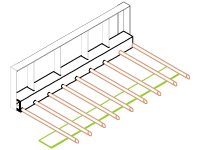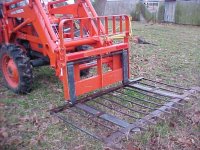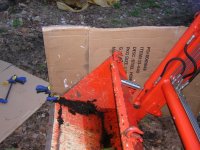DanR67
Silver Member
</font><font color="blue" class="small">( DanR67,
That does fit nice. I like that. I think that will work out well for you. You may find all sorts of things you can do with that attachment. )</font>
Funny thing is - I got the two pieces of steel from two different scrap yards several weeks apart - can't really ask for more! /forums/images/graemlins/laugh.gif (Well, OK - the steel did have to spend the winter outside under a tarp - so I've got to clean everything up with a wire wheel...Kubotabilly looks like he was working with "freshly minted" steel!)
</font><font color="blue" class="small">( I like your toplink too. I have never noticed a bar being used like that on the tractor side. Neat. )</font>
This was a bit of a necessity - as the original, thread-adjust toplink fit into a bracket - the hydraulic cylinder came with a clevis (?) / fork attachment at each end. SO...I basically had to come up with a "gender-changer" to adapt the cylinder - here a detailed picture. The original toplink rod was attached at the bottom pin IIRC.
</font><font color="blue" class="small">( A little clarification on the crushing issue. I think the design should be done such that the cylinder bottoms just as the arms snugs up tight. This still will not prevent the item you pick up (non-compressible like a log) from crushing your implement. So, IMHO you must have strength to use the tractor's relief valve or add a lower pressure one on the cylinder. )</font>
Yep - I understand this as well. Having the piston bottom is purely to prevent the grapple from crunching when doing an "air grab". The cylinder mount, bucket reinforcement, pivot points / final leverage / moments, and pressure limiting valves all must be designed / matched to the task at hand. I do want to try to make this "idiot proof" so I don't hose something because I stayed on the valve just a bit too long... /forums/images/graemlins/blush.gif
</font><font color="blue" class="small">( I wonder if you could use a 4 x 3 piece of angle iron attached to the top of the bucket's folded lip. Put the 4" inside the bucket. Put your grapple pivots on the 3" vertical side. Build your rear cylinder support on a plate that bolts on the back of the bucket and through to the angle iron along the top. If the 3" cyl strength is controlled, that should be strong enough and give a very low profile. The next time I am by the B, I'll have to look and see if I think this will work. This is all probably as clear as mud. /forums/images/graemlins/confused.gif /forums/images/graemlins/smile.gif
BTW: I think 125# is a reasonable weight.)</font>
I had to re-read this several times - but I get your drift. I like the idea of mounting the grapple pivots to the angle iron - that way the bucket stays nearly untouched - save for some mounting holes. I had also thought of doing some general kind of "bolt through" cylinder mount / reinforcement plate - your idea is just more specific - thanks! /forums/images/graemlins/smile.gif
Re: 125 lb weight: that's my guess-ti-mate. Now thinking about the angle iron and bolt-through reinforcing plates - the whole assembly may go up as high as 150 lbs. Still within reason, I feel.
Long term - one of the options that I have in mind is to build some kind of "quick-attach" system for my FEL bucket - so I could add some front forks in addition to my 3PH forks - don't want to fiddle with bolt-ons, because I think the weight will be too far forward. I plan to move small pallet loads of wood pellets in the front as well as the back - halving my trips. Each pallet weighs: 17 bags x 40 lbs = 680 lbs + the "mini-pallet" (pallets cut in half on the short axis). They are delivered one ton / full pallet (50 bags) - which I cannot move with my B7610 - so I restack them onto 3 "minis" - takes @ 10 - 12 minutes / ton.
If I get around to this - then I would "clean sheet" the grapple - as I would not have the crushing concerns nor geometry / clearance concerns of the FEL bucket to contend with. This would likely also negate the "weight penalty" - as any "pure grapple" would likely weigh less than the FEL bucket.
</font><font color="blue" class="small">( Another note, you get better open/close geometry with closely mounted pivots. When you spread them apart, it limits how much you can open. Not good in my opinion.)</font>
This is the ONE thing my larger cylinder works in my favor for: with the higher forces it can produce - I can place the pivot points closer together and get more "swing" (grapple jaw opening) distance - while producing the same amount of grapple force as a smaller cylinder.
</font><font color="blue" class="small">( Good stuff, hope you don't mind my opinions... )</font>
Thanks - am enjoying your input - as well as seeing / reading the many talents of our fellow TBNers only helps crystalize my ideas. Keep the feedback coming!
Cheers,
Dan
That does fit nice. I like that. I think that will work out well for you. You may find all sorts of things you can do with that attachment. )</font>
Funny thing is - I got the two pieces of steel from two different scrap yards several weeks apart - can't really ask for more! /forums/images/graemlins/laugh.gif (Well, OK - the steel did have to spend the winter outside under a tarp - so I've got to clean everything up with a wire wheel...Kubotabilly looks like he was working with "freshly minted" steel!)
</font><font color="blue" class="small">( I like your toplink too. I have never noticed a bar being used like that on the tractor side. Neat. )</font>
This was a bit of a necessity - as the original, thread-adjust toplink fit into a bracket - the hydraulic cylinder came with a clevis (?) / fork attachment at each end. SO...I basically had to come up with a "gender-changer" to adapt the cylinder - here a detailed picture. The original toplink rod was attached at the bottom pin IIRC.
</font><font color="blue" class="small">( A little clarification on the crushing issue. I think the design should be done such that the cylinder bottoms just as the arms snugs up tight. This still will not prevent the item you pick up (non-compressible like a log) from crushing your implement. So, IMHO you must have strength to use the tractor's relief valve or add a lower pressure one on the cylinder. )</font>
Yep - I understand this as well. Having the piston bottom is purely to prevent the grapple from crunching when doing an "air grab". The cylinder mount, bucket reinforcement, pivot points / final leverage / moments, and pressure limiting valves all must be designed / matched to the task at hand. I do want to try to make this "idiot proof" so I don't hose something because I stayed on the valve just a bit too long... /forums/images/graemlins/blush.gif
</font><font color="blue" class="small">( I wonder if you could use a 4 x 3 piece of angle iron attached to the top of the bucket's folded lip. Put the 4" inside the bucket. Put your grapple pivots on the 3" vertical side. Build your rear cylinder support on a plate that bolts on the back of the bucket and through to the angle iron along the top. If the 3" cyl strength is controlled, that should be strong enough and give a very low profile. The next time I am by the B, I'll have to look and see if I think this will work. This is all probably as clear as mud. /forums/images/graemlins/confused.gif /forums/images/graemlins/smile.gif
BTW: I think 125# is a reasonable weight.)</font>
I had to re-read this several times - but I get your drift. I like the idea of mounting the grapple pivots to the angle iron - that way the bucket stays nearly untouched - save for some mounting holes. I had also thought of doing some general kind of "bolt through" cylinder mount / reinforcement plate - your idea is just more specific - thanks! /forums/images/graemlins/smile.gif
Re: 125 lb weight: that's my guess-ti-mate. Now thinking about the angle iron and bolt-through reinforcing plates - the whole assembly may go up as high as 150 lbs. Still within reason, I feel.
Long term - one of the options that I have in mind is to build some kind of "quick-attach" system for my FEL bucket - so I could add some front forks in addition to my 3PH forks - don't want to fiddle with bolt-ons, because I think the weight will be too far forward. I plan to move small pallet loads of wood pellets in the front as well as the back - halving my trips. Each pallet weighs: 17 bags x 40 lbs = 680 lbs + the "mini-pallet" (pallets cut in half on the short axis). They are delivered one ton / full pallet (50 bags) - which I cannot move with my B7610 - so I restack them onto 3 "minis" - takes @ 10 - 12 minutes / ton.
If I get around to this - then I would "clean sheet" the grapple - as I would not have the crushing concerns nor geometry / clearance concerns of the FEL bucket to contend with. This would likely also negate the "weight penalty" - as any "pure grapple" would likely weigh less than the FEL bucket.
</font><font color="blue" class="small">( Another note, you get better open/close geometry with closely mounted pivots. When you spread them apart, it limits how much you can open. Not good in my opinion.)</font>
This is the ONE thing my larger cylinder works in my favor for: with the higher forces it can produce - I can place the pivot points closer together and get more "swing" (grapple jaw opening) distance - while producing the same amount of grapple force as a smaller cylinder.
</font><font color="blue" class="small">( Good stuff, hope you don't mind my opinions... )</font>
Thanks - am enjoying your input - as well as seeing / reading the many talents of our fellow TBNers only helps crystalize my ideas. Keep the feedback coming!
Cheers,
Dan




